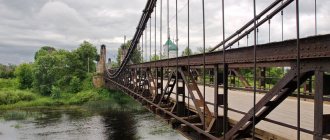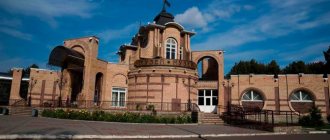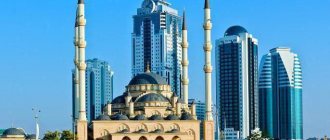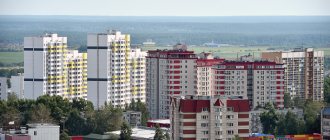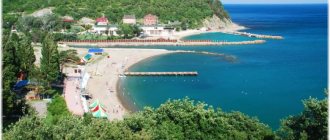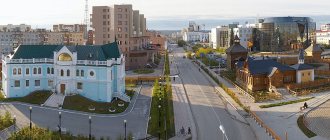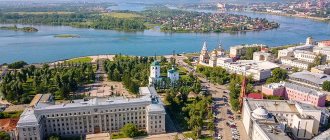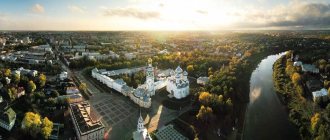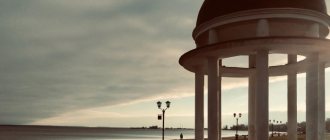Staraya Russa
Staraya Russa is a city of flower shops and funeral homes. Here, under the canopy of weeping willows and chestnut trees, the graceful Polist slowly carries its waters, and local canteens serve Buratino lemonade for six rubles per glass. All this is so wonderful that you immediately want to drink sweet soda, give some beautiful Rushanka a bouquet of flowers, walk with her along a quiet embankment overgrown with trees, and then die with a calm soul. Well, maybe before that you can also smear yourself with healing mud at a local resort, but this is not for everyone.
I came to Staraya Russa for the aeronautics festival, so I didn’t have time for all the above-mentioned entertainment - I only managed to run back and forth through the vegetable gardens a couple of times, avoiding the crowds of tourists, of which there were surprisingly many here.
No, of course, I knew that in Staraya Russa there is one of the oldest balneological and mud resorts in Russia. But I was sure that it had long been forgotten and abandoned by everyone. It turned out that the resort in Staraya Russa is not only not abandoned, but is even thriving. There are a dozen buildings on the territory, several relatively large hotels in the city center, a couple of small guest houses - and there are practically no places anywhere. And I thought it was a quiet province...
The province turned out to be really quiet after all. And although the tourists in the city are like uncut dogs, they all either cluster around the resort area fenced with a high fence, or explore the second main attraction of Staraya Russa - the Dostoevsky house-museum. By the way, both of these places of interest ultimately passed me by.
While I was flying in a hot air balloon, the scout I sent there, Dimon, was studying the resort. As soon as I landed, reconnaissance reported: the task was completed, there was nothing decisive to look beyond the fence. And we went to the Dostoevsky Museum. There, after hanging out in the cramped lobby with a couple of tourist groups, we bought two magnets from the ticket office instead of two tickets to the museum, and, pleased with ourselves, went for a walk around the city.
Here I cannot help but notice that next to the Dostoevsky Museum there is one of the most beautiful places in Staraya Russa - a miraculously preserved old cobblestone street laid along the river. No granite embankment, no parapets, no benches, no pseudo-Dostoevsky lanterns - only cobblestones and old willows bent over the surface of the water. Unfortunately, I didn’t think of photographing this miracle, although I probably should have - I’m afraid in a few years everything might be different there...
In general, Staraya Russa is one of the oldest Russian cities. It is located on the Polist River, at the confluence of the Porusya River (sometimes also called Pererytitsa).
Residents of Staraya Russa are called Rushans.
Despite it being Saturday evening, the city greeted us with silence; there were almost no drunks on the streets.
The balloon festival was in full swing. The balloons, solemnly launched from the central stadium, flew off into the distance, and only a large airship remained in the sky, leisurely floating back and forth over the city center.
In addition to the balneal and mud resort and the Dostoevsky Museum, Staraya Russa is famous for its temples. The most famous of them is the Resurrection Cathedral.
Once upon a time, the history of the city began from this place: there was a fortified fort here on the cape. Well, the first temple appeared here only in the 17th century. It was rebuilt several times, the last time almost two hundred years ago according to the design of the architect Stasov.
The Resurrection Cathedral had a particularly turbulent history in the 20th century - in Soviet times it managed to be a local history museum, which, by the way, has now moved to another cathedral, and a military museum, and a stable, and a club, and a cinema - in general, a rich biography , you can't say anything. Since the early 1990s, the building has again served its religious functions.
I have always been touched by the juxtaposition of recently restored Orthodox churches and Lenin monuments inherited from the USSR: so different - and yet together. Usually such a neighborhood is the first sign that you can find a lot of interesting things in the city.
My experience did not deceive me: Staraya Russa really had something to surprise. What was it worth at least for the episode when Dimon and I, having drunk a fair amount of Abkhaz wine, stood on the terrace of our guest house and enjoyed the Russian rock music coming from some neighboring gardens, performed to the accompaniment of an accordion.
The Resurrection Cathedral is, of course, beautiful. I’ve never been a fan of the pompous Russian Empire style, especially when it appears before me in the form of religious objects, but there’s definitely something in this temple.
By the way, the cathedral was painted in a bright brick-red color quite recently, just a few years ago. Before that, it was yellow for a long time.
You don’t even have to go anywhere to find beauty in Staraya Russa, it’s right in the air. For example, everything that has to do with the city is denoted by the possessive adjective “Old Russian”. Romance!
Starorussky district. Old Russian cheese. Old Russian vandals.
And although the latter do not sleep, in architectural terms Staraya Russa also has something to boast about.
On the central square - Sobornaya - there is an old water tower, built a hundred years ago, just then the first water supply system appeared in the city.
In Soviet times, this square bore the name of the Revolution, and before the revolution - Trade Square: Old Russian, Novgorod, Tver, Suzdal and Moscow merchants have long met here.
We walked leisurely, munching on pies bought at a nearby stall. A drunken woman was sitting on a podium that had appeared out of nowhere in the middle of the square: “Hey, guys, tell me the time?!”
Here, in one of the neighboring buildings, two new contenders for the title of “best window in the world” were unexpectedly found.
In general, from an architectural point of view, Staraya Russa is a post-war city. When it was liberated by Soviet troops in February 1944, there was not a single resident and practically not a single intact building left.
Having been rebuilt almost from scratch in the post-war years, this city somehow miraculously managed to preserve its Soviet, slightly neglected, but amazingly kind atmosphere. I thought that it could only be found in old films. But no - welcome to that Staraya Russa!
Lilacs are fragrant and chestnuts are blooming everywhere.
Chestnuts! Where did you last see blooming chestnuts in St. Petersburg? And in Staraya Russa - please, on every corner!
The buildings are gradually falling into disrepair.
Along with them, in order not to stand out, the old sidewalks, which have not seen repairs since Soviet times, also fall into disrepair.
The city lives its own life.
The walls of old Russian houses are decorated with the most elegant indicators of distances to hatches, drawn by hand. If you look closely, you can see their previous interpretation under the faded paint. I wouldn’t be surprised if there are several more ancient layers hidden underneath it.
Staraya Russa is very green. And very quiet. Even to me, who has been living in the countryside for eight years now, this silence seemed unnatural - it doesn’t get so quiet in cities.
An old wooden bridge leads to the opposite bank of the Polisti. It is located on the site of an ancient crossing. Once upon a time, this bridge was floating and swayed when loaded; because of this feature, the name “Live” was assigned to it. That's what they call him to this day.
After the revolution, the communist machine mercilessly swept through the cities of the USSR, renaming most of the streets, avenues and squares in a new way. The Old Russian communists decided to break away in a special way: when the surnames of party leaders for street names ran out, they turned on their imagination at full capacity, and this is how toponymic masterpieces like the October Events and the Proletarian Victory appeared. However, recently the process has reversed, and some streets have begun to be returned to their historical names.
Among all this communist schizophrenia, Svarog Street stands apart. The owner of the guest house where we lived told a funny story: some time ago, almost a scientific expedition came from Moscow to study the history of the name of this street. Imagine their disappointment when it turned out that the ancient Slavic god had absolutely nothing to do with it, and the street got its name in honor of a local artist who worked under such a pseudonym at the dawn of the USSR.
In the center of the city, between the Soviet four-story buildings and the vegetable gardens of local residents, the Spaso-Preobrazhensky Monastery has stood since the 12th century.
Let's climb the former bell tower. Let's look in one direction.
Then - to another. Let's be sad.
There are several museums located in the former monastery buildings. One of them is an art gallery of the same artist Svarog.
The second is a quite interesting local history museum.
Here you can learn the legend about Rus and Sloven - the epic ancestors of the Russian people. According to legend, in the middle of the 3rd millennium BC, the ancestors of the Slavs left the shores of the Black Sea and reached Lake Ilmen, in the north of which Sloven founded the city of Slovensk (now Veliky Novgorod), and in the south Rus founded the city of Rusa (now Staraya Russa ). In the legend you can find many other interesting episodes: about the Slavs’ campaigns against Egypt, and about negotiations with Alexander the Great, and about the visit of Apostle Andrew to Rus', and about much, much more, right up to Gostomysl’s calling Rurik to reign. In general, a most interesting work, even if it appeared only in the 17th century. Although, in fairness, different variations of this legend were found in various chronicles earlier, starting from the 10th century.
If we talk about more authoritative sources, then Staraya Russa was first mentioned in the middle of the 12th century. AD, of course. At the same time, archaeologists believe that already a hundred years before this, Rusa (that’s what the city was called until the 17th century) was already a developed settlement with wooden pavements and dense urban development.
From the very moment of its foundation, Staraya Russa was under the influence of Novgorod, until in the 15th century the city came under the rule of Moscow. All this time, Staraya Russa was an important center of salt production and trade.
At least twice in its history, the city was ruined almost to the ground - first, in the 17th century, the Swedes frolicked here very well, then in the 20th century - the Germans.
In the local history museum you can see an interesting collection of birch bark letters found on the territory of the city - ancient Russian mail, used until the 15th century.
Here, for example, is birch bark letter No. 10, dating from the 12th century: “This is a letter from Yarila to Onania. In Gorodishche, your domain, there is only water to drink (there is nothing left to eat). And the Rushans (residents of Rusa) mourn for the town residents. If you want, intimidate the nobles so that they don’t do anything dirty!”
But much more interesting is birch bark document No. 35, also from the 12th century.
It consists of two lines. First line: “From Radoslav to Choteslavow. Take ou prasol 2 hryvnia and 5 kouno.” Second line: “Yakov brother, fuck lying down, fuck, fuck.”
Next is a brief interpretation of the letter. Radoslav gives instructions to his brother Hoteslav: “Take 2 hryvnia and 5 kuna from the prasol (merchant).” Hoteslav categorically does not like this instruction: perhaps his brother is sending him to prasol instead of simply paying off his debt. He answers sarcastically and without hesitation in the form of expression. The address “Yakov brother” (and not “Radoslav”) is apparently ironic or even sarcastic: Khoteslav calls his brother not by his secular name, but by his baptismal name, and even with the word brother, which is appropriate only in a church or in a particularly solemn situation, but not in any way combined with the subsequent rudeness of “fuck lying down”. The latter carries the meaning - “Don’t be original, be like everyone else!” To this expression, Hoteslav adds two more intricate epithets for Radoslav-Jakov: “ebehota” - lustful, and the less clear “aesova” - most likely a compound word from “ae” - egg - and “sovati” - to poke.
Well, that's brilliant! There are no words. Nowadays they no longer know how to swear so gracefully.
By the way, this little document refutes the theory that Russian swearing appeared only during the Mongol-Tatar yoke. Fuck you, fuck him lying down!
Well, to conclude my story about Staraya Russa, I can’t help but tell you about the mineral springs. There are eight of them in the city, and all of them were drilled by hand.
The most famous of them is the Muravyovsky fountain, located directly on the territory of the resort. This is the most powerful mineral spring in Europe. Today it looks like an ordinary fountain, although in the old days an elegant pavilion was built above it (image credit).
I visited two lesser-known springs located on the outskirts of the city.
The first of them is Tsaritsynsky, drilled in the middle of the 19th century. It is just a huge rusty pipe sticking out of the ground. By the way, the depth of the well is 246 meters.
The second is Catherine's. It is located about fifty meters from Tsaritsynsky and is significantly inferior to it in power. It is unknown when it was drilled.
That's all for today.
Don't switch!
Continuation: A story about those who do not look for easy ways
Day five: December 18 - way home
I have long noticed that the road home always seems longer to me than the road to vacation. The distances seem to be the same, but for some reason it’s more difficult to drive. This fact is probably influenced by the emotional state. After all, when you go on vacation, you go in anticipation of something new and unknown, and when you return, you think about everyday worries and problems. Sadness is added here, the journey ends.
In general, this time the way home was no exception. We left Valdai at 9 am. The traffic was quite intense, there were a lot of trucks. But you can easily get around them; the road often turns from one lane to two.
There were cameras in all settlements; it was impossible to break the speed limit. In general, we drove slowly and carefully. It was still quite slippery in the morning.
We pulled out onto the first toll road and only then realized that we only had a quarter tank of gas. I didn’t want to move out right away, we hoped it would be enough. We go, we go, but it doesn’t end. We were flying 120 km/h, no oncoming traffic, no passing, nothing. They saw the workers and stopped. They said that the next exit to the M10 with gas stations is about 50 km away. And our gas gauge has already dropped.
What to do in such a situation? The repairmen offered two options: to stay and wait for the help they called, or to move on, hoping that the still splashing fuel would be enough to reach the treasured gas stations. We chose the second option. And you won’t believe it, the car stalled right in front of the barriers. And just opposite there was a building where the mobile emergency service was located, servicing this paid area.
The emergency crews said that we were very lucky. According to the plan, they have a control tour of the territory every four hours, they just returned from there. So, if it weren’t for the “happy accident,” we would have had to wait for them in the cold for a long time, because of course none of us wrote down the emergency phone numbers.
Life doesn't teach me anything. I’m giving you advice, but for the second time I’m stepping on the same rake. After all, less than six months have passed since the summer trip to Abkhazia, where the same situation with gasoline occurred. If you are interested in the details of the summer trip, read here.
This time, too, everything ended well for us. The “commissars” filled us with 7 liters for 300 rubles. Everything is official, with a receipt and signature on the delivery note. You could say they saved us. Very nice guys. Thank them very much!
Then we moved as usual. There were no traffic jams, the traffic was heavy, but working. Before reaching Tver, I got tired and relaxed a little. After the toll road, I forgot that there were also traffic lights.
The result showed immediately: a sharp brake at the intersection and driving beyond the control line. And of course, traffic police officers. I didn’t see their dear ones all the way, I just had to disturb them a little, and they were right there – standing right behind the intersection. Naturally, they stopped me and, of course, they issued me a fine of 800 rubles, 400 of which I paid immediately upon arriving home.
Actually, these are all incidents on the way back. In Solnechnogorsk there was a bit of jostling, and we also drove around Moscow for a long time along the Moscow Ring Road. But this was all predictable and we did not expect anything else.
The entire journey from Valdai to Lyubertsy took 7 hours. We arrived at the place around 16.00.
Recommendations for followers
Oddly enough, given the poor preparation for the trip this time, I don’t have any special complaints or corrections after the fact. I have already given several recommendations in the first part of the report, here are some more tips for the route:
- If you want to see more in Veliky Novgorod, or “don’t rush” to get acquainted with the local attractions of the city and surrounding area, then add at least one more day to your trip. Ideally, you need to set aside at least three days to study everything interesting. Two to Veliky Novgorod itself, and one to interesting places in the surrounding area.
- If you are very limited in time, you don’t have to go to Staraya Russa. The town certainly deserves attention, but no more than any other provincial town in Russia. This step will allow you to spend an extra half a day in Veliky Novgorod, or enjoy the magnificent nature of Valdai longer. Still, Staraya Russa is quite a big detour on our route.
- Buy food in shops at monasteries. If you have accommodation with a kitchen, this is a good food option. Their products (dumplings, dumplings, eggs, sour cream, twists) will allow you to eat nourishingly and tasty. And the cost is no more expensive than chain stores.
How much did you spend?
Initially we planned a budget trip. From the series: nothing superfluous, the less the better.
The numbers indicate only myself. I also took into account that the cost of the road there (1900 rubles for petrol + 750 rubles for tolls) was divided into two, and gasoline on the spot and on the way back - for three (1000 rubles for petrol there + 2150 rubles for additional costs + 750 RUR road fee). The cost of housing was simply divided by three. We ate mostly at home. Having summed up the receipts from the grocery store and rare cafes, I received the total amount for food.
- Road – 2625 rub.
- Housing – 3950 rub.
- Entrance tickets, excursions and theater - 2140 rubles.
- Meals – 2715 rub.
- Fine – 400 rubles. : for three = 135 rub.
Total: 11575 rub.
I didn't buy any souvenirs. The only thing I didn’t take into account in the final figure was notes and donations in Temples. But this is a personal expense item. And without them, the trip cost about 12,000 rubles. That's roughly what I originally planned to spend.
